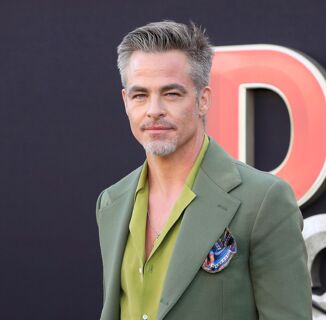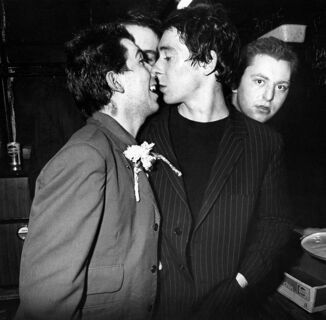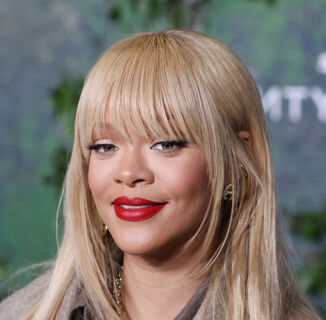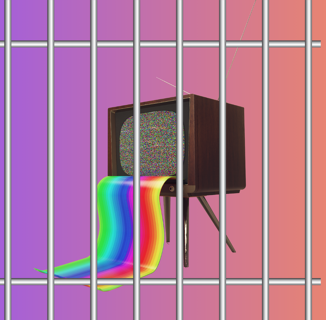Queer as Folk premiered almost two decades ago on Showtime. Its depiction of gay life among a group of Pittsburgh friends is intriguing, problematic, heartwarming, cringe-inducing and often corny. But the stories it wants to tell often have a lot to say about gay life in 2018. As such, INTO is embarking on a rewatch of the entire series, all five seasons and 83 episodes. In this week’s “Rewatch,” staff writer Mathew Rodriguez revisits episodes one through three of Season One. You are invited to follow along on Netflix, where all five seasons are currently streaming.
It’s probably appropriate that the very first episodes of Queer as Folk are so concerned with the mythology of gayness, as Queer as Folk feels like a part of so many queer men’s mythologies. Like the show itself, my own mythology begins with the opening credits. Sure, it’s just men bumping and grinding on each other to nondescript club music, but it’s also loud — louder than most of the program. The theme music was my signal to turn the volume on my TV all the way down. I’d watch the show almost silently, my face only a foot or so from the screen. And, of course, there were the two men dancing, one man’s dick butting up against another one’s butt cheeks.
There are a lot of shows I had to watch in secret, but none of them felt as naughty as Queer as Folk. I’d watch shows like Real Sex on HBO, aware that if I were caught, my mom would disapprove. But I knew that watching Queer as Folk would get both disapproval and questions, so I watched it as silently as possible, remote in hand, ready to channel surf if my mom happened to get up to use the bathroom. At that moment, my room had become a queer space and I was hypersensitive to the heterosexuality surrounding it.
Folk chooses to begin its narrative in a queer space: Babylon, a Pittsburgh club that the boys frequent. It’s there we meet three of the series’ protagonists and we get our first view of life inside a queer space: it sucks. The show depicts three of the characters — nerdy Michael, anxious Ted and fabulous Emmett — as uneasy inside the space, which is something I never quite picked up on while watching when I was younger. I, of course, thought that going to a gay bar would be great — being around other people, meeting a guy. Of course, the sex in the bar depicted in the show was equal parts titillating and frightening, but I wanted it.
Now, watching the show as an adult, I can see that it depicts queer spaces as fraught with tension — it’s where our insecurities bubble up, but also where opportunities present themselves. While Ted, Emmett and Michael are all handsome, none of them reach the same levels of pretty privilege as Brian, the hypersexual man for whom the club is akin to a hunting ground. Michael thinks he’s too nerdy, Ted thinks he’s not hot enough. And though Emmett is proud of his femme nature, he’s also aware that femininity is not always prized among his fellow gay men.
And then there’s Justin, the 17-year-old twink who is there cruising for dick and to find himself. When I used to watch the show, I felt like it wanted me to identify with Justin, because I too found myself scared and excited by the prospect of one day going to my first gay bar. (There was one rumored gay bar in my town. When you walked by, it always looked like it was closed. Black curtains blocked sunlight from the inside and I never saw anyone enter or leave.) But, being that I was a fat brown teenager who cocooned into a fat brown adult, I never fully saw myself in Justin. For one thing, I never thought of myself as someone who could catch a Brian.
Brian Kinney is by all accounts the hero of the series and he gets an almost theatrical entrance. Before we get to see him, the characters all talk about him and how hooking up at Babylon is a cakewalk for him. He’s what we’re taught to desire: white, generically handsome. That Justin desires him is no mystery. So often, we desire hot guys to validate our queerness as a kind of co-signing.
The age gap between the two is even more dramatic than the one presented in Call Me By Your Name. While Elio was 17 and Oliver was 24, Justin is 17 and Brian is 29, just on the cusp of being gay-and-30, its own stigma in a youth-obsessed culture. In that sense, the two enter into an almost symbiotic relationship. Brian offers Justin the experience and adjacency to coolness he so craves; to Brian, Justin makes him feel young, a prized thing in queer culture.
In Justin and Brian’s first sexual encounter, the show weaves together a bevy of queer tropes. Justin lies about his sexual experience to seem more grown-up. Justin wants the moment to be perfect, but it goes awry when Brian has to go to the hospital for the birth of his son with Lindsay, one half of the show’s resident lesbian couple. Justin has an image of what his first time will look like, and the show tears it asunder. He cums on Brian’s sheets; Brian gets mad. He has to go to the hospital and help name a baby. When he finally gets back to Brian’s house, he and Brian have an ecstasy-fueled fuckfest that leads Brian to be upset that he stayed the night. The show expertly plays with the tension between Justin’s desire to be the hookup that stays and Brian’s desire to have Justin hoof it home.
But Folk is also concerned with queerness in and out of queer spaces and the politics of code switching in heterosexual circumstances. Much of the first episode centers around Babylon and Brian’s apartment while the second episode zeroes in on queerness in straight-slash-neutral spaces. Ted must hide his webcam-jerking page from his boss. After an all night cum-a-thon with Brian, Justin goes back to high school where his sexuality makes him the subject of ridicule. And while Michael spends nights at Babylon trying to get laid, he presents as straight to coworkers and even allows an older coworker to joke about a gay couple walking through the store he manages by making a “limp wrist” movement. He even allows her to try to set him up with a newly-single female coworker.
The only one who the show presents as finding balance between their queer and work personae is Brian. As much as the show admits that he is an oversexed, quasi-sociopathic monster, it also refuses to leave his list of qualities so short. Rather, it applauds his unique talent to be 100% Brian at all times. An advertising executive who consistently gays up his marketing pitches, Brian is able to seduce a married man simply by cruising him in a professional setting. Brian’s queerness is just too strong to crush. While Michael withers among his coworkers, Brian is strong enough to turn any space queer.
Speaking of bathroom stalls, Michael and Brian share a kiss and fondle in a bathroom stall at Babylon one night. The show leaves no sexual area gray. While the friends confess they shouldn’t sleep with each other, Michael and Brian do have one sexual memory: they came out to each other when they jerked off to Patrick Swayze together. At one point, the show toys with the idea of Michael and Brian turning from best friends into lovers. That itself is a long-standing part of queer mythology: the idea that one day, your best friend will turn to you, tell you he loves you and cease all the pain of dating. But Brian pushes the brakes on that, in an early instance of the series’ habit of playing with the idea of gay fantasy vs. gay reality.
And finally, we have to talk about the place where the show is most harsh: its treatment of women. Now, it’s a bit *too* easy to point out that most of the men on the show, especially Brian, are misogynistic pieces of shit. In a lot of ways, Brian’s misogyny is part of his monstrous side. Casual misogyny among queer men is an all-too-common problem, but the show makes Brian’s misogyny far too casual. It doesn’t seem to condemn it to the level that it should. No one checks him on the way he speaks about queer women. Nowhere is that tension more evident than in Brian’s relationship with Melanie, Lindsay’s partner. (I won’t go into it too much here, but there are still 80 episodes left to go to zero in on that issue, because it deserves its own space.)
At the same time, Brian is the only male character on the show (so far) who is actively trying to queer a family structure that includes both queer men and queer women. Though he was fucking Justin while Lindsay was giving birth to his biological son, Gus, Brian is fiercely protective of his son, even to the point of stopping his religious circumcision ceremony, protesting against anyone attempting to change his body while he’s still such a young baby.
At its core, mythology explains. Why do we have the four seasons? Well, because of the love between Hades and Persephone. Coral exists because Medusa’s head is rolling around the sea turning everything to stone. Similarly, Queer as Folk is obsessed with queer mythologies and undertakes the hefty task of explaining the mechanics of queer spaces by diving into a cast of queer individuals. As with many shows, it often succeeds and sometimes it fails. But, just as I learned as a baby gay who turned the show down to the lowest decibels for fear of being found out, the show has a lot to say if you listen carefully…
Help make sure LGBTQ+ stories are being told...
We can't rely on mainstream media to tell our stories. That's why we don't lock our articles behind a paywall. Will you support our mission with a contribution today?
Cancel anytime · Proudly LGBTQ+ owned and operated
Read More in Culture
The Latest on INTO
Subscribe to get a twice-weekly dose of queer news, updates, and insights from the INTO team.
in Your Inbox














